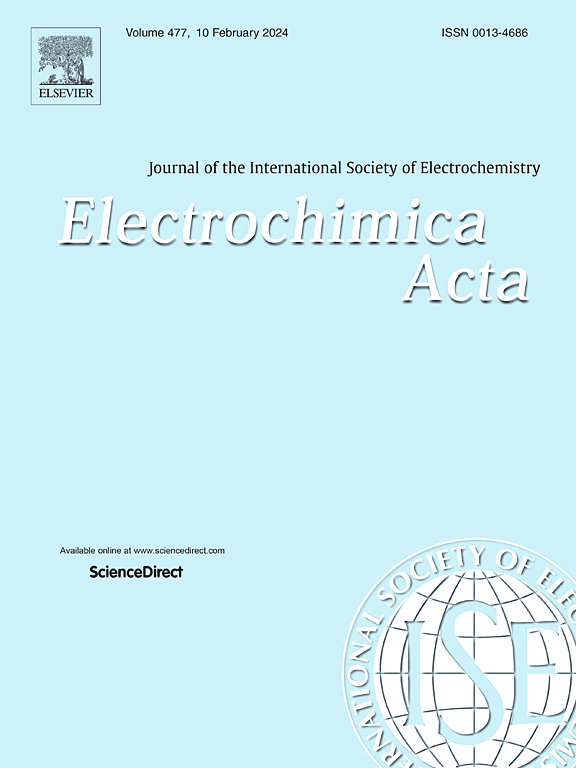Pyrrolidinium- and Imidazolium-stabilized 2,2,6,6-tetramethylpiperidin-1-oxyl nitroxyl radical electrolytes for high-voltage and redox-enhanced nonaqueous supercapacitors
IF 5.6
3区 材料科学
Q1 ELECTROCHEMISTRY
引用次数: 0
Abstract
Nonaqueous organic redox electrolyte-enhanced electrochemical double-layer capacitors (N![]() ORECs) are promising candidates for high-energy and high-power grid applications. Unlike traditional aqueous ORECs, N
ORECs) are promising candidates for high-energy and high-power grid applications. Unlike traditional aqueous ORECs, N![]() ORECs benefit from a significantly wider electrochemical stability window enabled by organic solvents. However, the electrochemical instability of organic redox electrolytes near marginal potentials restricts window optimization. Here, we develop two stable nitroxide radical-based redox electrolytes by introducing propoxy-linked, electron-conjugated methylimidazolium and methylpyrrolidinium cations into 2,2,6,6-tetramethylpiperidin-1-oxyl (TEMPO) cores and coupling with aluminum-stable BF₄⁻ anions, namely MimP-TBF4 and MpyP-TBF4, respectively. Theoretical calculations confirm that the electron-withdrawing nature of imidazolium and pyrrolidinium cationic groups delocalizes the electron density of the N
ORECs benefit from a significantly wider electrochemical stability window enabled by organic solvents. However, the electrochemical instability of organic redox electrolytes near marginal potentials restricts window optimization. Here, we develop two stable nitroxide radical-based redox electrolytes by introducing propoxy-linked, electron-conjugated methylimidazolium and methylpyrrolidinium cations into 2,2,6,6-tetramethylpiperidin-1-oxyl (TEMPO) cores and coupling with aluminum-stable BF₄⁻ anions, namely MimP-TBF4 and MpyP-TBF4, respectively. Theoretical calculations confirm that the electron-withdrawing nature of imidazolium and pyrrolidinium cationic groups delocalizes the electron density of the N![]() O moiety in TEMPO, thereby enhancing the stability of its radical and oxoammonium states. Interestingly, the MpyP-TBF4 first demonstrates higher ionic conductivity, diffusion coefficient and rate constant compared to MimP-TBF4 because of the weaker interactions between aliphatic pyrrolidinium cations and acetonitrile, enabling it has faster mass/charge transport dynamics. Consequently, the MpyP-TBF4 assembled N
O moiety in TEMPO, thereby enhancing the stability of its radical and oxoammonium states. Interestingly, the MpyP-TBF4 first demonstrates higher ionic conductivity, diffusion coefficient and rate constant compared to MimP-TBF4 because of the weaker interactions between aliphatic pyrrolidinium cations and acetonitrile, enabling it has faster mass/charge transport dynamics. Consequently, the MpyP-TBF4 assembled N![]() ORECs acquire a 3.2 V high cell voltage, a notable energy density and power density (48.2 Wh kg−1 and 23.9 kW kg−1, respectively), as well as outstanding cycling stability with 88.5 % capacitance retention after 10,000 cycles. This study offers a promising design for organic redox electrolytes in high-performance N
ORECs acquire a 3.2 V high cell voltage, a notable energy density and power density (48.2 Wh kg−1 and 23.9 kW kg−1, respectively), as well as outstanding cycling stability with 88.5 % capacitance retention after 10,000 cycles. This study offers a promising design for organic redox electrolytes in high-performance N![]() ORECs.
ORECs.
吡啶和咪唑稳定的2,2,6,6-四甲基哌啶-1-氧基硝基自由基电解质用于高压和氧化还原增强的非水超级电容器
非水有机氧化还原电解质增强电化学双层电容器(N-ORECs)是高能量和高功率电网应用的有前途的候选者。与传统的水性ORECs不同,N-ORECs受益于有机溶剂带来的更宽的电化学稳定性窗口。然而,有机氧化还原电解质在边缘电位附近的电化学不稳定性限制了窗口优化。在这里,我们开发了两种稳定的基于硝基自由基的氧化还原电解质,通过将丙氧基电子共轭的甲基咪唑和甲基吡啶离子引入2,2,6,6-四甲基胡椒碱-1-氧(TEMPO)核心,并与铝稳定的BF₄毒血症(mmp - tbf4和mpp - tbf4)偶联。理论计算证实,咪唑和吡啶阳离子基的吸电子性质使TEMPO中N-O部分的电子密度离域,从而增强了其自由基和氧铵态的稳定性。有趣的是,与MimP-TBF4相比,mpp - tbf4首先表现出更高的离子电导率、扩散系数和速率常数,这是因为脂肪族吡啶离子与乙腈之间的相互作用较弱,从而使其具有更快的质量/电荷传输动力学。因此,MpyP-TBF4组装的N-ORECs获得了3.2 V的高电池电压,显著的能量密度和功率密度(分别为48.2 Wh kg - 1和23.9 kW kg - 1),以及出色的循环稳定性,在10,000次循环后保持88.5%的电容。该研究为高性能N-ORECs中的有机氧化还原电解质提供了一种有前途的设计。
本文章由计算机程序翻译,如有差异,请以英文原文为准。
求助全文
约1分钟内获得全文
求助全文
来源期刊

Electrochimica Acta
工程技术-电化学
CiteScore
11.30
自引率
6.10%
发文量
1634
审稿时长
41 days
期刊介绍:
Electrochimica Acta is an international journal. It is intended for the publication of both original work and reviews in the field of electrochemistry. Electrochemistry should be interpreted to mean any of the research fields covered by the Divisions of the International Society of Electrochemistry listed below, as well as emerging scientific domains covered by ISE New Topics Committee.
 求助内容:
求助内容: 应助结果提醒方式:
应助结果提醒方式:


